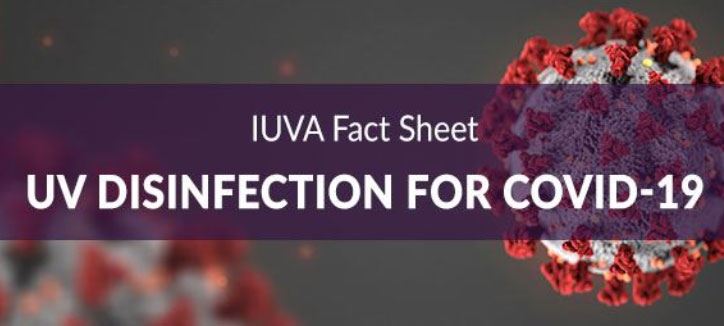Advancing the sciences, engineering & applications of ultraviolet technologies to enhance the quality of human life & to protect the environment. |

IUVA Fact Sheet on UV Disinfection for COVID-19
It must be noted that “UVC”, “UV disinfection” and “UV” as used here and in the scientific, medical and technical literature, specifically and importantly refers to UVC light energy (200-280nm light) in the germicidal range which is not the same as the UVA and UVB used in tanning beds or sunlight exposure. Facts on UV and COVID-19Can UVC help prevent COVID-19 transmission by reducing contamination?Based on existing evidence, we believe so. Here’s why: UVC light has been used extensively for more than 40 years in disinfecting drinking water, waste water, air, pharmaceutical products, and surfaces against a whole suite of human pathogens (Fluence UV Dose Required review IUVA). All bacteria and viruses tested to date (many hundreds over the years, including other coronaviruses) respond to UV disinfection. Some organisms are more susceptible to UVC disinfection than others, but all tested so far do respond at the appropriate doses.
Are UVC disinfection devices safe?Like any disinfection system, UVC devices must be used properly to be safe.) They all produce varying amounts of UVC light in wavelengths of 200nm-280nm. This UVC light is much “stronger” than normal sunlight, and can cause a severe sunburn-like reaction to your skin. The target tissue in the eye would be the cornea (rather than the retina). The effect on the cornea is called photokeratitis, which is also known as welder’s flash or snow-blindness, is like a sunburn of the eye. It’s unlikely that any of the UVC light would penetrate through the cornea and then lens to reach the retina because of the short wavelength (i.e. high frequency). Some devices also produce ozone as part of their cycle, others produce light and heat like an arc welder, others move during their cycles. Hence, general machine-human safety needs to be considered with all disinfection devices, and these considerations should be addressed in the operations manual, in the user training, and appropriate safety compliance. Are there performance standards and UVC validation protocols for UV disinfection devices?Given the wide array of UVC devices marketed for disinfection of air, water and solid surfaces, the lack of uniform performance standards and the highly variable degree of research, development and validation testing that is performed on different devices, the IUVA urges consumers to exercise caution when selecting equipment and look for evidence of third party testing as well as certification of device materials and electrical components by well-known organizations such as NSF, UL, CSA, DVGW-OVGW or other international requirements as applicable. For UVC devices designed to inactivate air and solid surfaces in the healthcare industry, members of IUVA are working diligently with other national standards organizations in the lighting and healthcare industry to develop disinfection testing standards[x]. The goal is to develop guidance that will help healthcare providers world-wide choose the best possible technologies for their institutions to use in the fight against multiple drug resistant organisms and other pathogens[xi], like the COVID-19 virus. ResourcesNIST Journal: Special Section on UV Technologies for Public Health Interest in ultraviolet-C (UV-C) irradiation as a strategy for decontaminating surfaces in the health care environment has skyrocketed during the COVID-19 pandemic. But with a lack of standards and regulations surrounding the technology’s implementation, consistent safety and efficacy is no guarantee. In response to the growing need for guidance, the Journal of Research of the National Institute of Standards and Technology (NIST) has published a Special Section on Ultraviolet Technologies for Public Health in collaboration with the International Ultraviolet Association (IUVA) following a joint workshop on this critical topic for public health in January 2020. More Information »Please find presentations, posters, and other information from the NIST/IUVA 2020 Workshop on Ultraviolet Disinfection Technologies & Healthcare Associated Infections: Defining Standards and Metrology Needs Supporting Global Action to Reduce the Transmission Of COVID-19, CIE Releases Two Publications on Ultraviolet Radiation Disinfection - FOR FREE http://cie.co.at/news/cie-releases-two-key-publications-uv-disinfection Advice (i.e., tips) for the selection and operation of equipment for the UV disinfection of air and surfaces http://iuva.org/Advice-selection/operation-of-equipment-for-the-UV-disinfection-of-air-and Standards for European medical devices and personal protective equipment available free of charge from The German Institute for Standardization (DIN) https://www.din.de/en/din-and-our-partners/press/press-releases/covid-19-din-makes-standards-for-medical-equipment-available-708628 Illuminating Engineering Society. IES CR-2-20-V1, IES Committee Report: Germicidal Ultraviolet (GUV) – Frequently Asked Questions. New York: IES, 2020. https://media.ies.org/docs/standards/IES-CR-2-20-V1-6d.pdf References:[i] “Miscellaneous Inactivating Agents - Guideline for Disinfection and Sterilization in Healthcare Facilities (2008);” Centers for Disease Control and Prevention, National Center for Emerging and Zoonotic Infectious Diseases (NCEZID), Division of Healthcare Quality Promotion (DHQP) (https://www.cdc.gov/infectioncontrol/guidelines/disinfection/disinfection-methods/miscellaneous.html) [ii] “Large-scale preparation of UV-inactivated SARS coronavirus virions for vaccine antigen,” Tsunetsugu-Yokota Y et al. Methods Mol Biol. 2008;454:119-26. doi: 10.1007/978-1-59745-181-9_11. [iii] “Efficacy of an Automated Multiple Emitter Whole-Room Ultraviolet-C Disinfection System Against Coronaviruses MHV and MERS-CoV,” Bedell K et al. ICHE 2016 May;37(5):598-9. doi:10.1017/ice.2015.348. Epub 2016 Jan 28. [iv] “Focus on Surface Disinfection When Fighting COVID-19”; William A. Rutala, PhD, MPH, CIC, David J. Weber, MD, MPH; Infection Control Today, March 20, 2020 (https://www.infectioncontroltoday.com/covid-19/focus-surface-disinfection-when-fighting-covid-19) [v] Ibid. [vi] “Preventing the Spread of Coronavirus Disease 2019 in Homes and Residential Communities”; National Center for Immunization and Respiratory Diseases (NCIRD), Div. of Viral Diseases (https://www.cdc.gov/coronavirus/2019-ncov/hcp/guidance-prevent-spread.html) [vii] “New coronavirus stable for hours on surfaces”; CDC (extracted from N van Doremalen, et al. Aerosol and surface stability of HCoV-19 (SARS-CoV-2) compared to SARS-CoV-1. The New England Journal of Medicine. DOI: 10.1056/NEJMc2004973 (2020) (https://www.nih.gov/news-events/news-releases/new-coronavirus-stable-hours-surfaces). [viii] “Inactivation of SARS coronavirus by means of povidone-iodine, physical conditions and chemical reagents;” Kariwa H et al. Dermatology 2006;212 (Suppl 1): 119 (https://www.ncbi.nlm.nih.gov/pubmed/16490989) [ix] “Ultraviolet Radiation and the Work Environment (Revised. See: 74-121),” The National Institute for Occupational Safety and Health (NIOSH), Page last reviewed: March 29, 2017 (https://www.cdc.gov/niosh/docs/73-11005/default.html) [x] “Pathway to Developing a UV-C Standard – A Guide to International Standards Development”, C. Cameron Miller and Ajit Jillavenkatesa, IUVA News / Vol. 20 No. 4, 2018 [[xi] “Healthcare Associated Infections Workshop Advances Development Of Ultraviolet Disinfection Technologies,” IUVA Press Release, dated 24 Jan 2020 4:14 PM (http://iuva.org/Projects-Articles-Repository/8672736) |

 The International Ultraviolet Association (IUVA) believes that UV disinfection technologies can play a role in a multiple barrier approach to reducing the transmission of the virus causing COVID-19, SARS-CoV-2, based on current disinfection data and empirical evidence. UV is a known disinfectant for air, water and surfaces that can help to mitigate the risk of acquiring an infection in contact with the COVID-19 virus when applied correctly. "The IUVA has assembled leading experts from around the world to develop guidance on the effective use of UV technology, as a disinfection measure, to help reduce the transmission of COVID-19 virus. Established in 1999, the IUVA is a nonprofit dedicated to the advancement of ultraviolet technologies to help address public health and environmental concerns," says Dr. Ron Hofmann, Professor at the University of Toronto, and President of the IUVA.
The International Ultraviolet Association (IUVA) believes that UV disinfection technologies can play a role in a multiple barrier approach to reducing the transmission of the virus causing COVID-19, SARS-CoV-2, based on current disinfection data and empirical evidence. UV is a known disinfectant for air, water and surfaces that can help to mitigate the risk of acquiring an infection in contact with the COVID-19 virus when applied correctly. "The IUVA has assembled leading experts from around the world to develop guidance on the effective use of UV technology, as a disinfection measure, to help reduce the transmission of COVID-19 virus. Established in 1999, the IUVA is a nonprofit dedicated to the advancement of ultraviolet technologies to help address public health and environmental concerns," says Dr. Ron Hofmann, Professor at the University of Toronto, and President of the IUVA. The IUVA’s COVID-19 Response
The IUVA’s COVID-19 Response